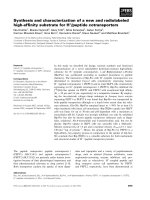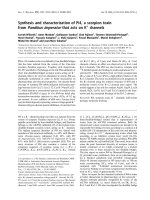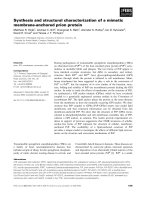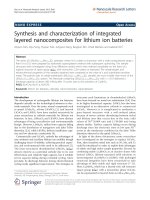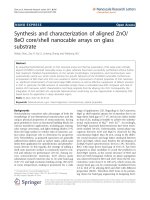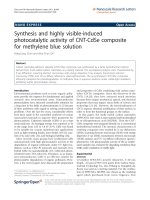Báo cáo hóa học: "Synthesis and characterization of Nb2O5@C core-shell nanorods and Nb2O5 nanorods by reacting Nb(OEt)5 via RAPET (reaction under autogenic pressure at elevated temperatures) technique" potx
Bạn đang xem bản rút gọn của tài liệu. Xem và tải ngay bản đầy đủ của tài liệu tại đây (362.69 KB, 7 trang )
NANO EXPRESS
Synthesis and characterization of Nb
2
O
5
@C core-shell nanorods
and Nb
2
O
5
nanorods by reacting Nb(OEt)
5
via RAPET (reaction
under autogenic pressure at elevated temperatures) technique
P. P. George Æ V. G. Pol Æ A. Gedanken
Published online: 27 October 2006
Ó to the authors 2006
Abstract The reaction of pentaethoxy niobate,
Nb(OEt)
5
, at elevated temperature (800 °C) under
autogenic pressure provides a chemical route to nio-
bium oxide nanorods coated with amorphous carbon.
This synthetic approach yielded nanocrystalline parti-
cles of Nb
2
O
5
@C. As prepared Nb
2
O
5
@C core-shell
nanorods is annealed under air at 500 °C for 3 h
(removing the carbon coating) results in neat Nb
2
O
5
nanorods. According to the TEM measurements, the
Nb
2
O
5
crystals exhibit particle sizes between 25 nm
and 100 nm, and the Nb
2
O
5
crystals display rod-like
shapes without any indication of an amorphous char-
acter. The optical band gap of the Nb
2
O
5
nanorods was
determined by diffuse reflectance spectroscopy (DRS)
and was found to be 3.8 eV.
Keywords Niobia Á Nanoparticles Á Core-shell
structure Á Diffused reflection spectroscopy
Introduction
Inorganic nanoparticles with controlled size and shape
are technologically important due to the strong corre-
lation between these parameters and their magnetic,
opto-electrical, and catalytic properties [1, 2]. Niobium
materials have been of special interest due to their
opto-electronic properties [3]. In addition, they are
used for various important catalytic reactions. The
important features of niobium compounds are the
promoter effect and the support effect. Niobium oxides
remarkably enhance catalytic activity and prolong
catalyst life when small amounts are added to known
catalysts. Moreover, niobium oxides exhibit a pro-
nounced effect as supports of metal and metal oxide
catalysts [4].
The carbon coating of ceramic particles such as
Al
2
O
3
, TiO
2
and MgO, as well as metal particles, are
expected to be useful in improving their chemical and
physical properties, and are also thought to increase
resistance to environmental attack such as corrosion
and oxidation. In addition, carbon-coated ceramic
particles display improved electrical conductivity.
There are a variety of techniques for coating the
carbon on nanoparticles, e.g., the electric arc discharg-
ing method, which has been used for the production of
carbon nanocapsules by coating minute amounts of
carbon on metals [5, 6]. However, the reproducibility
and homogeneity of these carbon-coated metal parti-
cles are not very high, and so their large-scale produc-
tion is difficult.
Gedanken and co-workers have found a novel
method for the carbon coating of a large variety of
nanoparticles such as V
2
O
5
,MoO
3
,MgCNi
3
,
MgCxCo
3
and WO
3
at elevated temperatures under
autogenic pressure, and eventually producing a vari-
ety of core-shell nanostructures [7–9]. The technique
of this synthetic approach is termed RAPET (reac-
tions under autogenic pressure at elevated tempera-
tures). It does not require any expensive equipment
and only involves the simple procedure of adding the
precursor to a Letlok cell and heating at 600–1,000 °C
under air or under inert atmosphere. Because of its
P. P. George Á V. G. Pol Á A. Gedanken (&)
Department of Chemistry and Kanbar Laboratory for
Nanomaterials, Bar-Ilan University Center for Advanced
Materials Nanotechnology, Bar-Ilan University,
Ramat-Gan 52900, Israel
e-mail:
Nanoscale Res Lett (2007) 2:17–23
DOI 10.1007/s11671-006-9023-7
123
simplicity and ease of application to other ceramics,
theRAPETtechniqueisexpectedtobeaonestep,
efficient process for carbon-coating.
There are various methods for the production of
Nb
2
O
5
materials [4, 10–13]. Tsuzuki et al. reported on
the formation of Nb
2
O
5
of 100–1,000 nm by a mec-
hano-chemical synthetic approach [10]. However, the
Nb
2
O
5
nanoparticles produced were found to be in an
aggregated form. The solvothermal approach is an-
other technique for the production of Nb
2
O
5
materials
[11]. Both techniques have produced amorphous
Nb
2
O
5
and require further heat treatment to induce
crystallization. To overcome these drawbacks, we
describe a simple one-step and efficient method for
the synthesis of highly crystalline Nb
2
O
5
by employing
the RAPET method. The advantage of this method
over other techniques is that the as-prepared samples
are already nanocrystalline in nature. In the present
study, carbon-coated crystalline Nb
2
O
5
nanorods have
been synthesized using a one-step RAPET technique.
Experimental
The synthesis of Nb
2
O
5
@C core-shell nanorods is carried
out by the thermal dissociation of pentaethoxy niobate,
Nb(OEt)
5
, which was purchased from the Aldrich
company and used as received. The 3 mL closed vessel
cell was assembled from stainless steel Letlok parts
(manufactured by the HAM-LET Co., Israel). A 1/2¢¢
union part was plugged from both sides by standard caps
as shown in Fig. 1a and b. For the synthesis, 1.5 g of the
Nb(OEt)
5
was introduced into the cell at room temper-
ature under nitrogen (a nitrogen-filled glove box). The
filled cell was closed tightly by the other plug and then
placed inside an iron pipe in the middle of the furnace.
The temperature was raised at a heating rate of 10 °C/
min. The closed-vessel cell was heated at 800 °Cfor3h.
The reaction took place under the autogenic pressure of
the precursor. The letlok was gradually cooled (~5h)to
room temperature, and after opening, a black powder
was obtained. The total yield of the product material was
59% of the total weight of the materials introduced into
the cell. [The yield was the final weight of the product
relative to the weight of Nb(OEt)
5
, the starting material].
The synthesis of nanomaterials by the RAPET method
required the use of simple equipment, a comparatively
low temperature, and a short reaction time, to create
pure Nb
2
O
5
@C nanorods (Sample A). The as-prepared
Nb
2
O
5
@C nanorods were further annealed at 500 °C
under air for 3 h. The annealing removes the carbon
layer and leads to the formation of white Nb
2
O
5
nanorods (Sample B).
15 20 25 30 35 40 45 50 55 60 65 70 75 80 85
0
50
100
150
200
250
300
350
400
(381)
(200)
(182)
(010)
(380)
(002)
(181)
(180)
(001)
)stnuoC(niL
2-Theta-scale
(c)
(b)
(a)
15 20 25 30 35 40 45 50 55 60 65 70 75 80 85
0
100
200
300
400
500
600
(381)
(182)
(380)
(010)
(002)
(201)
(181)
(200)
(180)
(001)
)stnuoc(niL
2-theta-Scale
(d)
Fig. 1 (a) An overview of the Letlok used for the RAPET
reaction and (b) a cross-section of the Letlok; D: cap, E: union.
PXRD pattern of (c) the thermally decomposed Nb(OEt)
5
at
800 °C under inert atmosphere, (d) the thermally decomposed
Nb(OEt)
5
at 800 °C under inert atmosphere and further
annealed at 500 °C under air for 3 h
18 Nanoscale Res Lett (2007) 2:17–23
123
Characterization
The XRD patterns of samples A and B were recorded
using a Bruker D8 diffractometer with Cu Ka radiation.
C, H analysis was carried out on an Eager 200 CE
instrument and an EA 1110 Elemental Analyzer. The
morphologies of the as-prepared sample, and also of the
annealed product, were studied by a scanning electron
microscope (SEM) coupled with energy dispersive
X-ray analysis (EDX). Transmission electron micros-
copy (TEM) studies were carried out on a JEOL 2000
electron microscope. High-resolution TEM (HRTEM)
images were taken using a JEOL 2010 with 200 kV
accelerating voltage. Samples for the TEM and
HRTEM measurements were obtained by placing a
drop of the suspension from the as-sonicated reaction
product in ethanol onto a carbon-coated copper grid,
followed by drying under air to remove the solvent.
EDX studies were carried out on a Jeol micrograph
(JEOL 2010 operated at 200 kV). The Olympus BX41
(Jobin Yvon Horiba) Raman spectrometer was em-
ployed, using the 514.5 nm line of an Ar ion laser as the
excitation source to analyze the nature of the carbon
present in Nb
2
O
5
@C composite. A Micromeritics
(Gemini 2375) surface area analyzer was used to
measure the surface area of Nb
2
O
5
@C core-shell
nanorods and neat Nb
2
O
5
nanorods. The diffuse reflec-
tance spectroscopy (DRS) was carried out using a
UV-visible spectrometer (VARIAN CARY 100 Scan).
Results and discussion
Powder X-ray diffraction (PXRD), elemental
(C and H) analysis, SEM, HRSEM and EDX
analysis
The XRD patterns of the thermally-decomposed
Nb(OEt)
5
at 800 °C in a closed Letlok cell under inert
atmosphere are presented in Fig. 1c. In Fig. 1c, a
representative XRD pattern for our as-synthesized
carbon-coated niobium oxide nanorods is displayed.
All the main peaks can be indexed undisputedly to
Nb
2
O
5
[powder diffraction file (PDF) no. 00-027-1003].
The degree of carbon graphitization was deduced from
the PXRD results. The absence of graphite peaks
indicates the possibility that carbon is present only as
amorphous carbon. The diffraction peaks at 2h = 22.6,
28.4, 28.8, 36.6, 37.0, 46.2, 50.0, 50.9, 55.1 and at 56.4°
are assigned to (001), (180), (200), (181), (201), (002),
(010), (380), (182) and (381) planes of Nb
2
O
5
, respec-
tively. From the (180) diffraction peak, the average
interlayer spacing was calculated as 3.15 A
˚
. The
average crystallite size for Nb
2
O
5
@C and Nb
2
O
5
was
calculated as ca 28 ± 4 nm using the Debye-Scherrer
equation.
When considering the presence of a uniform layer of
carbon coated on Nb
2
O
5
, as will be shown later, the
formed product was termed a ‘‘Niobium oxide-carbon’’
(NOC) core-shell nanoparticle. To eliminate the car-
bon, the NOC core-shell was annealed at 500 °C under
air. The elemental (C, H, N, S) analysis detected 0%
carbon and 0% hydrogen in the product after the
annealing process. The diffraction peaks, peak inten-
sities, and cell parameters are in agreement with the
diffraction peaks of the crystalline orthorhombic phase
of Nb
2
O
5
(PDF No. 00-027-1003). The peaks of
orthorhombic Nb
2
O
5
are narrower compared to those
of the Nb
2
O
5
@C sample, indicating either a crystallite
growth due to the sintering of neighboring particles or
because of the release of microstrains during the
annealing process.
The calculated elemental (wt) percentages of C, H,
O and Nb in the [Nb(OEt)
5
] precursor are 37.0%,
8.0%, 25.0%, and 29.0%, respectively. We could
determine the carbon and hydrogen content in the
Nb
2
O
5
@C sample with an elemental [C, H, N and S]
analyzer. The measured amount of carbon in the
Nb
2
O
5
@C sample is 11.64 wt%, while the amount of
hydrogen is reduced to 0.14%. Therefore, the final
product, Nb
2
O
5
@C, contains a 33 wt% of the total
carbon content that was initially present in the
Nb(OEt)
5
. It is clear that the amount of carbon and
hydrogen in the Nb
2
O
5
@C sample is reduced, as
compared with the precursor, because gases such as
CO
2
,C
x
H
y
(hydrocarbons) and/or H
2
are formed
during the decomposition of the precursor. These
gases are liberated as a result of overpressure and
upon the opening of the closed Letlok cell [7–9].
The morphologies of the products were observed by
SEM, HRSEM, TEM and HRTEM analysis. The
morphologies of the Nb
2
O
5
@C core-shell nanoparticles
and the Nb
2
O
5
obtained after annealing at 500 °C
under air atmosphere are primarily investigated by
SEM measurements. Figure 2a and b demonstrates the
SEM images of an as-prepared sample, Nb
2
O
5
@C and
neat Nb
2
O
5
nanorods, respectively. The sample shows
various morphologies, including flakes of different
shapes as well defined, rod-shaped particles. The
average thickness of the various flakes is ~100 nm.
Elemental analysis measurements of the NOC core
shell revealed the presence of C in the as-prepared
sample. Figure 2b demonstrates the SEM images of
neat Nb
2
O
5
obtained after annealing the Nb
2
O
5
@C
sample at 500 ° C under air. As stated above, the
carbon coverage has completely disappeared after the
Nanoscale Res Lett (2007) 2:17–23 19
123
annealing treatment. Although many of the flakes are
still observed in the SEM picture, the nanorods are also
appeared among the annealed particles. The stacking
of two or more nanorods (indicated by arrows) is
appeared in the SEM images (Fig. 2b). This rod
assembly might be due to the sintering of the rods,
which occurs upon annealing at 500 °C under air for
3 h. EDX measurements of Nb
2
O
5
@C core-shell
nanorods and neat Nb
2
O
5
nanorods indicates the
presence of only Nb and oxygen and no other impu-
rities are observed. The composition of the Nb
2
O
5
@C
and neat Nb
2
O
5
, obtained from EDX analysis, gives
Nb/O atomic ratio ~2.5:1 in agreement with Nb
2
O
5
.
TEM and HRTEM measurements
The structure of the Nb
2
O
5
@C core shell was further
studied by TEM and HRTEM measurements. The
TEM image of a few of the rod-shaped Nb
2
O
5
@C
particles obtained by the thermal decomposition of
Nb(OEt)
5
at 800 °C is illustrated in Fig. 3a. The as-
formed Nb
2
O
5
@C core-shell nanorods have an average
thickness of 45–150 nm and lengths of 100–350 nm.
Figure 3b demonstrates the HRTEM image of the
edge of a single Nb
2
O
5
@C core-shell nanorod. The
image is recorded along the [180] zone. The measured
distance between these (180) lattice planes is 0.32 nm,
which is very close to the distance between the planes
reported in the literature (0.31 nm) for the orthorhom-
bic lattice of the Nb
2
O
5
[powder diffraction file (PDF)
No. 00-027-1003]. The corresponding selected area
electron diffraction (SAED) pattern is demonstrated in
Fig. 3c, featuring a single crystal of Nb
2
O
5
@C core-
shell nanoparticles (respective planes are highlighted).
In order to identify the composition of core-shell
nanorods (HRTEM, Fig. 3a), we have measured a
Fig. 3 TEM images of
(a)Nb
2
O
5
@C core-shell
nanorods, (b) a HRTEM
image of the edge of a
Nb
2
O
5
@C core-shell nanorod
with the plane (180). A
uniform amorphous carbon
coating of 5–10 nm thickness
is clearly seen at the edge of
nanorod (marked by black
arrow). (c) A SAED pattern
of Nb
2
O
5
@C core-shell
nanorods (respective planes
are highlighted)
Fig. 2 (a) SEM images
demonstrating the Nb
2
O
5
@C
core-shell nanoparticles. (b)
SEM images of neat Nb
2
O
5
nanorods obtained after
annealing the Nb
2
O
5
@C core-
shell nanorods at 500 °C
under air for 3 h. The dashed
arrow points to stackings of
nanorods. The full arrows
point to individual nanorods
20 Nanoscale Res Lett (2007) 2:17–23
123
selected area EDS analysis of the individual Nb
2
O
5
@C
crystalline particles (Fig. 4). The measurements dem-
onstrate the existence of 69.0 wt% of Nb and 31 wt%
of O, which is very close to the theoretical value of
Nb
2
O
5
(Nb = 69.9 wt% and O = 30 wt%). The carbon
peak originates from the carbon shell. The peaks of
copper originate from the TEM copper grid.
Figure 5 depicts the TEM image of the morphology
of the neat Nb
2
O
5
particles. Nanorods are the major
structure observed in the picture. They are obtained
after annealing the Nb
2
O
5
@C core-shell nanorods at
500 °C. The neat Nb
2
O
5
nanorods have an average
thickness of 100 nm and lengths between 100 nm and
300 nm. According to our interpretation, the carbon in
the as-prepared Nb
2
O
5
@C acts as a glue, and it glues
together the nanorods of Nb
2
O
5
, forming flakes of
various shapes. Once the glue is removed, the basic
shape of the niobia, the nanorods, is exposed.
The results of the Brunauer-Emmett-Teller surface
area measurements of the as-prepared Nb
2
O
5
@C core-
shell nanorods prepared under an inert atmosphere
and the Nb
2
O
5
@C core-shell nanorods annealed at
500 °C under air are 14.8 and 14.4 m
2
/g, respectively.
We have carried out the optical DRS measurement
of the neat Nb
2
O
5
nanorods in order to resolve the
excitonic or interband (valence conduction band)
transitions of Nb
2
O
5
, which allows us to calculate the
band gap. Figure 6 depicts the optical DRS of the
Nb
2
O
5
. An estimate of the optical band gap is obtained
using the following equation for a semiconductor [14]:
Fig. 4 Selected area EDS
analysis of Nb
2
O
5
@C
Fig. 6 Diffuse reflectance spectrum (DRS) of Nb
2
O
5
nanorod as
a function of F(R) versus wavelength (nm)
Fig. 5 TEM images of neat Nb
2
O
5
nanorods
Nanoscale Res Lett (2007) 2:17–23 21
123
aðmÞ¼Að"hm=2 ÀE
g
Þ
m=2
;
where "h ¼ h=p, "hm = photon energy, a is the absorption
coefficient, and m is dependent on the nature of the
transition. For a direct transition, m is equal to 1 or 3,
while for an indirect-allowed transition, m is equal to 4
or 6. Since A is proportional to F(R), the Kubelka-Munk
function F(R) = (1 – R)
2
/2/R, the energy intercept of a
plot of (F(R)*hm)
2
and (F(R)*hm)
1/2
versus hm yields the
E
g, dir
for a direct-allowed transition and the E
g, ind
for
an indirect-allowed transition, respectively, when the
linear regions are extrapolated to the zero ordinate [14].
Using this method, from the spectrum we calculated the
band gap of Nb
2
O
5
to be 3.8 eV (325 nm). The value of
the band gap energy is shorter than that in the literature,
where the bulk band gap is 4.87 eV [15].
We have no explanation for the discrepancy
between the bulk value and the band gap measured
in this study.
Discussion
The suggested mechanism was based on the obtained
analytical data and on a few control experiments, as well
as on previously published data. From XRD, EDX,
elemental (C, H, N, S) analysis, SEM, HRSEM, TEM,
and HRTEM analysis, it was clear that the product, the
Nb
2
O
5
@C core-shell nanorods, were obtained as a
result of the thermal dissociation of Nb(OEt)
5
under
inert atmosphere. A vapor–solid process was presumed
to control the formation of the one-dimensional nano-
structures, nanotubes, or nanowires [7]. According to
our interpretation, the dissociation of Nb(OEt)
5
at
800 °C leads to an atomization of the precursor into
carbon, hydrogen, oxygen, and perhaps niobium atoms.
The niobium and oxygen atoms then react, and upon
cooling form a rod-shaped Nb
2
O
5
via the fast reactions
of ether elimination and b-hydrogen transfer [16]. The
occurrence of these reactions, providing oxide nano-
particles in both solution and gas phase thermolysis of
metal alkoxides, was earlier demonstrated by us in a
series of mechanistic studies [7–9]. Our previous
articles, demonstrate that all the products of the
dissociation reaction float in the gas phase and solidify
immediately after their formation [7]. The question is
what solidifies first and what determines the order of the
solidification. In the case of the previous RAPET
reaction of tetraethyl orthosilicate (TEOS), we could
account for the solidification of the carbon [11] by the
spherical core, both thermodynamically and kinetically.
The present reaction can be explained only on a kinetic
basis. Since the boiling and melting points of carbon are
much higher than those of the transition metal oxides,
thermodynamic carbon would, therefore, tend more
easily to become a solid at 800 °C. In other words, from
the thermodynamic point of view, carbon would be the
first to solidify and form the core, and the Nb
2
O
5
would
create the shell. However, since the process is kineti-
cally controlled, the opposite occurs. Namely, carbon,
having a slower solidification rate, forms the shell layer,
and Nb
2
O
5
has a much higher solidification rate than
carbon for forming the core of the composite. The
mechanism for the formation of a similar core-shell
structure was discussed in earlier reports [17, 18].
Similar reactions, under the same conditions, were
conducted for VO(OC
2
H
5
)
3
and MoO(OMe)
4
. In both
cases, the process is kinetically controlled, and V
2
O
3
nanoparticles [17] or MoO
2
nanoparticles [18] showed a
higher solidification rate than carbon to form the core of
the composite.
Conclusions
Here we present a method for the synthesis of
Nb
2
O
5
@C core-shell nanorods. The presented method
is a novel, simple, efficient reaction for the direct
preparation of core-shell nanoparticles by a single step
process. Anealing the Nb
2
O
5
@C core-shell nanorods,
at 500 °C under air to produce pure Nb
2
O
5
nanorods.
Acknowledgements P. P. George thanks the Bar-Ilan Research
authority for a post-doctoral fellowship. We are also thankful to
Ms. Louise Braverman for editorial assistance. Technical support
from Dr. Yuri Koltypin is gratefully acknowledged.
References
1. X. Liu, G. Qiu, X. Li, Nanotechnology 16, 3035 (2005)
2. T. Ahmad, K.V. Ramanujachary, S.E. Lofland, A.K. Gang-
uli, J. Nan. Sci. Technol. 5, 1840 (2005)
3. A. Gargi, G.B. Reddy, J. Mater. Sci: Mater. Elect. 16,21
(2005)
4. Y. Chen, I.E. Wachs, J. Catal. 146, 323 (1994)
5. M. Inagaki, H. Miura, H. Konno, J. Eur. Ceram. Soc. 18,
1011 (1998)
6. M. Inagaki, Y. Okada, H. Miura, Carbon 37, 329 (1999)
7. S.V. Pol, V.G. Pol, V.G. Kessler, G.A. Seisenbaeva, M. Sung,
S. Asai, A. Gedanken, J. Phys. Chem. B 108, 6322 (2004)
8. S.V. Pol, V.G. Pol, A. Gedanken, Chem. Eur. J. 10, 4467
(2004)
9. V.G. Pol, S.V. Pol, A. Gedanken, Y. Goffer, J. Mater. Chem.
14, 966 (2004)
10. N. Uekawa, T. Kudo, F. Mori, J. Colloid. Interf. Sci. 264, 378
(2003)
11. T. Tsuzuki, P.G. Mecomick, Mater. Trans. 42, 8 (2001)
12. O. Friedrichs, F. Aguey-Zinsou, J.R.A. Fernandez, Acta
Mater. 54, 105 (2006)
22 Nanoscale Res Lett (2007) 2:17–23
123
13. A. Markus, N. Markus, P. Nicola, Colloids Surf. A 250, 211
(2004)
14. K.V. Luca, S. Djajanti, R.F. Howe, J. Phys. Chem. B 102,
10650 (1998)
15. G. Agarwal, G.B. Reddy, J. Mater. Sci: Mater. Elect. 16,21
(2005)
16. S.V. Pol, V.G. Pol, V.G. Kessler, A. Gedanken, New
J. Chem. 30, 370 (2006)
17. A. Johansson, M. Roman, A.G. Seisenbaeva, L. Kloo, Z.
Szabo, V.G. Kessler, J. Chem. Soc. Dalton Trans. 387(2000)
18. S.V. Pol, V.G. Pol, V.G. Kessler, G.A. Seisenbaeva, M G.
Sung, S. Asai, A. Gedanken, J. Phys. Chem. B 108,6322(2004)
Nanoscale Res Lett (2007) 2:17–23 23
123
